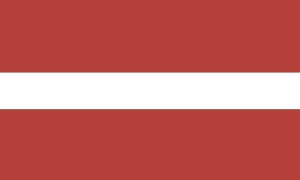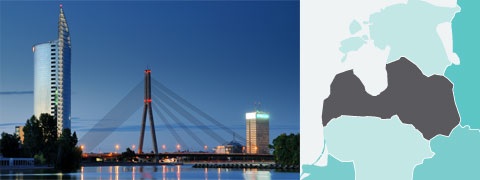Country assessments
Latvia
- Details
- Country assessments
2013 sector transition indicators
Source: EBRD.
Note: Water – Water and wastewater; IAOFS – Insurance and other financial services; PE – Private equity.
Highlights
- Latvia registered Europe’s strongest growth rate in 2012 and, while the growth rate declined in 2013 it has remained healthy. This growth was underpinned primarily by consumption on the back of a rapid improvement in the labour market. Net emigration has therefore fallen sharply.
- Latvia was successful in securing the adoption of the euro in 2014. This will eliminate the remaining currency risk in the financial system, secure access to refinancing instruments from the European Central Bank (ECB), and provide greater credibility and institutional support to Latvia’s banking supervision regime. Achieving eurozone membership just a few years after Latvia’s major economic crisis in 2008-09 is a testament to the country’s highly successful macroeconomic adjustment effort and its overall resilience.
- Governance of the numerous state-owned enterprises has been further strengthened. The initiation of membership discussions with the Organisation for Economic Co-operation and Development (OECD) should further strengthen such standards.
Key priorities for 2014
- Implementation of the competitiveness agenda that was set out in 2011 is crucial. This agenda addresses, in particular, skills shortages – which are a traditional bottleneck in the labour market – as well as raising the level of research and development among private companies, which is the lowest in the European Union (EU) as a proportion of GDP.
- Further efforts are needed to raise labour force participation. Measures that are required to further this aim include reform of the tax system and raising support payments to low-income households, coupled with appropriate training efforts aimed at low-skilled workers.
- Monitoring the Latvian financial system should be boosted with the start of the single supervisory mechanism in the eurozone in 2014. However, vigilance is needed. Given its traditional links to countries of the Commonwealth of Independent States (CIS), and given also Latvia’s much-strengthened credibility from its accession to the euro area, Latvia may attract more non-resident deposits into the small number of credit institutions that specialise in this business and that will remain under the remit of the local supervisor. While supervision has already been reinforced, overall systemic risks for the domestic financial system need to be carefully monitored.
Macroeconomic performance
Latvia continued to demonstrate among the highest growth rates in Europe. Growth of 5.0 per cent in 2012 extended a very strong recovery that began in the previous year. However a substantial gap to the pre-crisis peak in economic activity remains. Growth in the first half of 2013, of about 3.8 per cent in annual terms, similarly underlined that all principal components of demand contributed to growth, with domestic consumption particularly strong as the labour market recovered.
Unemployment fell further, to 11.3 per cent, in the second quarter of 2013, which represents a significant fall, from its peak of over 20 per cent in early 2009. Crucially, the improvement over the last year stemmed in large part from a recovery in employment, which rose by 2.8 per cent over 2012. Meanwhile, the workforce also grew, underlining that net emigration has slowed substantially, and that restraint in real wage growth continues to fuel further hiring by private employers. Nevertheless, long-term unemployment (of more than one year’s duration) remains at about half of total unemployment, which is well above the EU average.
Export volume continued to grow at a strong pace in 2012, of 9.4 per cent. This support for the economic recovery was partly attributable to a much-improved harvest, but it also stemmed from the success of some Latvian exporters, particularly for a number of technology-intensive product categories. Moreover, Latvia has been slightly sheltered from the European recession through its broader diversification of export markets, and with access to Scandinavian and CIS markets. Unit labour costs have seen only modest increases in the period 2011-12, and Latvia registered small gains in share of world markets over the past three years. More recently, in the first half of 2013, overall export growth has moderated, as growth in manufacturing industries has become more subdued, including because of the temporary closure of Latvia’s largest steel plant.
Latvia’s fiscal deficit was reduced to 1.3 per cent, below earlier targets that were already ambitious. According to budget plans the deficit should remain at a similar level in 2013. Given present growth levels, government debt is on a stable trajectory, from current modest levels of approximately 43 per cent of GDP. In January 2013 the parliament adopted a Fiscal Discipline Law, which will limit the structural deficit over the course of the economic cycle, and which provides for independent oversight through a new fiscal council.
The European Council, in July 2013, approved Latvia’s application to join the euro area from 2014 at current parity to the euro. With this step, Latvia will eliminate any remaining exchange rate risk (which was sizeable during the crisis), allowing its banks to access the refinancing facilities of the ECB, and assume greater credibility in its banking supervision under the framework of the emerging European Banking Union.
Major structural reform developments
Latvia has initiated significant reductions in the personal income tax rate. However, after an initial cut in early 2013, further planned cuts have been put on hold in the 2014 budget, while reductions in social security contributions are under consideration. In addition, relief payments will be available for low-income wage earners and families that have traditionally suffered from the most onerous tax and benefit disincentives against participation in the labour market. There will be across-the-board reductions in personal tax rates, coupled with the phasing out of out-of-work payments for new entrants to the labour market. Latvia’s labour force participation rate was 68.1 per cent at end of 2012, which was well below the EU target of 75 per cent, although this ratio has increased over the course of the economic recovery.
Higher tax revenues in 2012 indicate improved tax compliance and collection efforts. In January 2013 new measures to combat the pervasive shadow economy came into effect, including through rules to curtail informal cash payments by employers.
The first stages of the pension system reform were implemented; the retirement age will be gradually raised until 2025. According to EU projections, the dependency ratio (of the inactive population to those of working age) is set to deteriorate sharply over the next 50 years. At the same time, payments into the second pillar pension funds will be gradually increased until 2016, when they will reach 6 per cent of gross pay, as was envisaged some years ago.
Alleviating the most pressing fiscal risks will also allow for a more forward-looking strategy of implementing the agenda that was set out in the 2011 Latvian Competitiveness Report. Relative to GDP, Latvia continues to exhibit the lowest private expenditure on research and development in the EU. In this regard, the further reform of the higher education system – in which many institutions are poorly funded and offer degrees of limited relevance to the labour market – is encouraging. The expansion of the small number of facilities for vocational education, much of which comes out of EU structural funds, is also crucial, in particular to addressing the pressing problem of youth unemployment.
Some progress was made in relation to the governance of state-owned enterprises. A central governance bureau for state-owned institutions will be in place by early 2014, which will exercise state ownership centrally, and will pass guidelines on corporate governance to all executives in such enterprises. To this end, senior executives and board members of the largest state-owned enterprises have been given further training. Latvia’s initiation of membership negotiations with the OECD – which was formally approved by that institution in June 2013 – could assist further progress in this area.
The integration of Latvia’s power market with the EU power market has advanced. Initial implementation of the memorandum on the Baltic Energy Market Interconnection Plan (BEMIP), which was signed in 2009 and aimed to further integrate the Baltic electricity market with the EU market, has been slow. Following the signing of an agreement between the Latvian independent electricity system operator and the operator of the integrated Nord Pool Spot, a Latvian bidding area became effective in June 2013. Nord Pool Spot is to become the market operator of the new Latvian spot price. Full liberalisation of tariffs for retail electricity consumers remains under consideration for 2014, although this is dependent upon a comprehensive initiative by the government to structure compensating payments to the poorest households.
Power connections to Belarus, Russia and Estonia are still prioritised, while connections to Scandinavia and Poland remain inadequate and require further investment. Energy cooperation with the other two Baltic countries was complicated in October 2012 by Lithuania’s rejection, in a referendum, of a planned nuclear power plant. While Lithuania is pressing ahead with a new liquefied natural gas terminal, the other two Baltic states and Finland await an EU decision on the location of a plant that is to be partly financed by EU structural funds.
Latvia has an advanced system of supervision and regulation for its banking sector. Latvia remains a traditional centre for deposits by non-residents, which account for around half of all deposits. The Latvian financial supervisor further strengthened the supervision of such accounts when concerns over the diversion of funds from other European locations emerged, and the growth of non-resident deposits has remained manageable. The adoption of the euro in early 2014 will dispel any remaining currency risks in the financial system, and should further strengthen bank supervision under the emerging European Banking Union. However, local supervisory attention to smaller banks will remain important.
The government has reinstituted contributions from wages into private pension funds to previously planned levels. This should assist the development of local capital markets. The programme of public bond issues by Latvenergo, a state-owned company, was initiated in December 2012, and will eventually see bonds of over €120 million issued. These bonds encountered strong demand among domestic investors – including pension funds – and these bond issues represent notable progress in the opening up of alternative channels of long-term funding.













